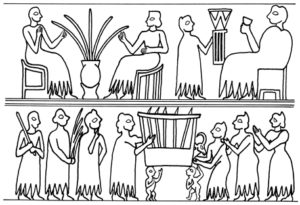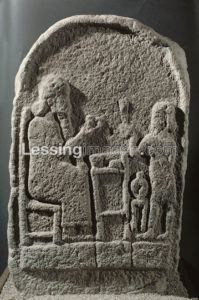(Texts: All Artifacts, Color Coding, & Writings in Bold Type With Italics Inside Parenthesis, are Added by Editor R. Brown, not the Authors, Translators, or Publishers!)
(gods in blue …mixed-breed demigods in teal…)
“’Fetch him the bread of eternal life and let him eat!’
They fetched him the bread of eternal life, but he would not eat.
They fetched him the water of eternal life, but he would not drink.
They fetched him a garment, and he put it on himself.
They fetched him oil, and he anointed himself.
An watched him and laughed at him.
‘Come Adapa, why didn’t you eat?
Why didn’t you drink?”
Didn’t you want to be immortal?
Alas for downtrodden people!’
‘But Enki my lord told me:
‘You mustn’t eat! You mustn’t drink!’`…
‘Take him and send him back to his earth’ ….”
“Then Gilgamesh raised a punting pole and drew the boat to shore.
Utanapishtim spoke to Gilgamesh, saying:
“Gilgamesh, you came here exhausted and worn out.
What can I give you so you can return to your land?
I will disclose to you a thing that is hidden, Gilgamesh, a… I will tell you.
There is a plant… like a boxthorn, whose thorns will prick your hand like a rose.
If your hands reach that plant you will become a young man again.”…
“He took the plant, though it pricked his hand, …
Gilgamesh spoke to Urshanabi, the ferryman, saying:
“Urshanabi, this plant is a plant against decay(!) by which a man can attain his survival(!).
I will bring it to Uruk-Haven, and have an old man eat the plant to test it.
The plant’s name is ‘The Old Man Becomes a Young Man.’
Then I will eat it and return to the condition of my youth.”
“Gilgamesh went down and was bathing in the water.
A snake smelled the fragrance of the plant, silently came up and carried off the plant.
While going back it sloughed off its casing.’
At that point Gilgamesh sat down, weeping, …”
Elixer of Life
Ceremonial drinking scene on a seal found in the “Great Death Pit” in the Royal Cemetery at Ur. In the top register, left, a man and a woman use straws to drink a liquid, probably beer, from a large jar on a stand between them. On the same level, right, sits a figure, likely female (goddess), raising a cup before a standing figure, possibly a servant. In the lower register, a woman plays a bull-headed lyre, in front of which two dwarves dance. On the far right, three women clap while dancing(?). On the far left, two women, perhaps with musical instruments, stand in front of a man with a staff. Lapis lazuli. Dated ca. 2550-2400 B.C.E.
Drawing © S. Beaulieu, after Aruz 2002: 109 #60c.

